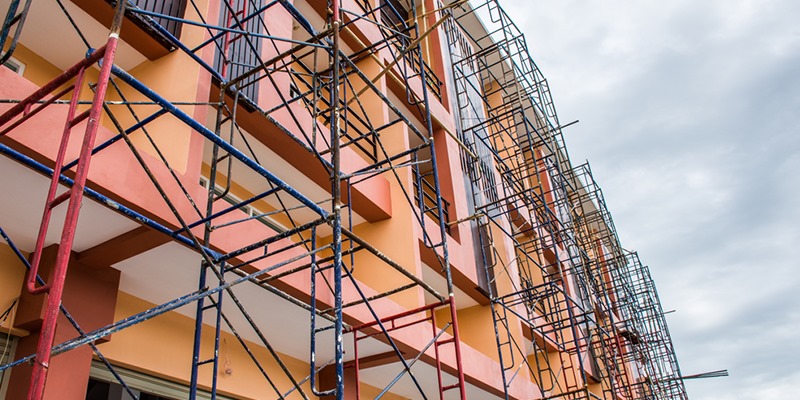Scaffolding in the Construction and Infrastructure Industry

When we look at towering skyscrapers reaching for the clouds, intricate bridges spanning vast rivers, or sprawling infrastructure projects connecting communities, our attention is often drawn to the final, majestic structures. Yet, behind every impressive build lies a crucial, temporary framework that makes it all possible: scaffolding.
Far from just a collection of poles and planks, scaffolding is the unsung hero of the construction and infrastructure industry. It provides the essential backbone for workers, materials, and equipment, enabling safe and efficient operations at every stage of a project.
More Than Just a Temporary Structure: Its Vital Roles
Scaffolding's importance goes far beyond mere access. It plays several indispensable roles:
Ensuring Worker Safety: This is the paramount function. Scaffolding provides stable, secure platforms and safe passage for construction workers. It significantly reduces the risk of falls, which remain a leading cause of fatalities and injuries in the industry. By offering steady footing and guardrails, it allows workers to focus on their tasks rather than their precarious position.
Facilitating Efficient Workflows: When workers have easy, stable access to every part of a structure, their productivity soars. Tools and materials can be readily moved and placed, minimizing wasted time and effort. This efficiency directly impacts project timelines and labor costs.
Supporting Heavy Loads: Scaffolding systems are engineered to bear significant weight – not just workers, but also heavy construction materials, tools, and machinery. This load-bearing capability is critical for masonry work, façade installation, large-scale plastering, and more.
Enabling Precision and Quality: Many construction tasks, especially those requiring intricate detailing or alignment, demand a stable and precise working environment. Scaffolding provides this stability, allowing for higher quality workmanship and adherence to design specifications.
Versatility Across Projects: From small residential renovations to massive bridge constructions, power plants, and industrial complexes, scaffolding is adaptable. Different types – like traditional tube-and-coupler, modular system scaffolds (e.g., Cuplock, Ringlock), suspended scaffolds, or mobile towers – can be deployed to suit unique structural challenges and work requirements.
The Evolution of Scaffolding
Modern scaffolding is a far cry from its rudimentary predecessors. Today's systems are the result of advanced engineering, rigorous testing, and adherence to strict safety standards. They feature:
High-Strength Materials: Typically made from robust steel or lightweight aluminum, designed for durability and reusability.
Modular Designs: Allowing for quick and efficient assembly and dismantling, reducing downtime.
Safety Features: Integrated guardrails, toe boards, access ladders, and advanced bracing systems.
Digital Planning: Utilizing CAD software and 3D modeling for precise design and optimal material usage.
The Importance of Choosing the Right Partner
Given its critical role, the choice of scaffolding supplier and service provider is paramount. A reputable provider will not only offer quality, certified equipment but also provide expert design, safe erection and dismantling services, and regular inspections. This holistic approach ensures compliance with safety regulations and mitigates risks.
Conclusion
Scaffolding, though temporary, leaves a lasting impact on every construction and infrastructure project. It's the silent enabler, the steadfast support, and the fundamental element that transforms ambitious blueprints into tangible realities. By recognizing its vital role and prioritizing quality solutions, the industry continues to build bigger, better, and most importantly, safer for everyone involved.
Frequently Asked Questions (FAQs) About Scaffolding
Q1: What is the primary purpose of scaffolding in construction?
The primary purpose of scaffolding is to provide a safe, stable, and elevated working platform for construction workers, as well as to support materials and equipment, allowing for efficient work on various parts of a structure.
Q2: What are the most common types of scaffolding?
Common types include: * Supported scaffolding: Built from the ground up, like frame, system, and tube-and-coupler scaffolds. * Suspended scaffolding: Platforms suspended by ropes or cables from above, such as swing stages. * Mobile scaffolding: Supported scaffolds with wheels, allowing them to be easily moved.
Q3: How often should scaffolding be inspected?
Scaffolding should be inspected before each work shift, after any event that could affect its structural integrity (e.g., strong winds, heavy rain, impact), and at regular intervals as per safety regulations. A competent person should perform these inspections.
Q4: Is scaffolding rental a better option than buying?
For most projects, renting scaffolding is more cost-effective. It eliminates storage, maintenance, and depreciation costs. Rental companies also ensure that equipment meets safety standards and is appropriate for the job.
Q5: What safety measures are crucial when working on scaffolding?
Key safety measures include proper training for all workers, wearing appropriate personal protective equipment (PPE) like hard hats and fall protection, maintaining clear platforms, not overloading the scaffold, and ensuring stable footing for all components.

